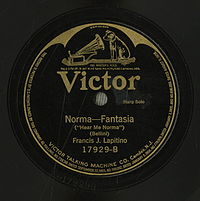A-side and B-side
This article needs additional citations for verification. (June 2022) |

The A-side and B-side are the two sides of phonograph records and cassettes, and the terms have often been printed on the labels of two-sided music recordings. The A-side usually features a recording that its artist, producer, or record company intends to be the initial focus of promotional efforts and radio airplay, with the aim of it becoming a hit record. The B-side (or "flip-side") is a secondary recording that typically receives less attention, although some B-sides have been as successful as, or more so than, their A-sides.
Use of this language has largely declined in the 21st century as the music industry has transitioned away from analog recordings towards digital formats without physical sides, such as downloads and streaming. Nevertheless, some artists and labels continue to employ the terms A-side and B-side metaphorically to describe the type of content a particular release features, with B-side sometimes representing a "bonus" track or other material.[1]
History
[edit]Conventions shifted in the early 1960s, at which point record companies started assigning the song they wanted radio stations to play to side A, as 45 rpm single records ("45s") dominated most markets in terms of cash sales in comparison to albums, which did not fare as well financially. Throughout the decade the industry would slowly shift to an album-driven paradigm for releasing new music; it was not until 1968 that the total production of albums on a unit basis finally surpassed that of singles in the United Kingdom.[2]
Today, with the vast majority of music released and accessed digitally on streaming services, the traditional A-side/B-side is obsolete as a technological necessity. Nonetheless, some contemporary artists have added on a second track to a single release as a nominal B-side, which can serve as an aesthetic choice as well as a promotional tool.[3]
Double A-side
[edit]A double A-side, AA-side, or dual single is a single where both sides are designated the A-side, with no designated B-side; that is, both sides are prospective hit songs and neither side will be promoted over the other. In 1949, Savoy Records promoted a new pair of singles by one of its artists, Paul Williams' "House Rocker" and "He Knows How to Hucklebuck", as "The New Double Side Hit – Both Sides 'A' Sides".[4] In 1965, Billboard reported that due to a disagreement between EMI and John Lennon about which side of the Beatles' "We Can Work It Out" and "Day Tripper" single should be considered the A-side and receive the plugging, "EMI settled for a double-side promotion campaign—unique in Britain."[5]
In the UK, before the advent of digital downloads, both A-sides were accredited with the same chart position, for the singles chart was compiled entirely from physical sales. In the UK, the biggest-selling non-charity single of all time was a double A-side, Wings' 1977 release "Mull of Kintyre"/"Girls' School", which sold over two million copies. It was also the UK Christmas No. 1 that year.[6][7] Nirvana released "All Apologies" and "Rape Me" as a double A-side in 1993, and both songs are accredited as a hit on both the UK Singles Chart[8] and the Irish Singles Chart.[9]
B/W
[edit]The term "b/w", an abbreviation of "backed with", is often used in listings to indicate the B-side of a record. The term "c/w", for "coupled with", is used similarly.[10]
Characteristics
[edit]B-sides are often considered to be filler material: songs of lower quality. However, some pop artists such as Prince, The Smiths, Def Leppard, Oasis, Bon Jovi and The Beatles have been particularly known for releasing strong material on B-sides.[11][12] B-sides have often been compiled on expanded or "deluxe" editions of albums or may be compiled into a "B-side compilation album" across multiple periods of an artist's career.[13]
B-side compilations
[edit]See also
[edit]References
[edit]- ^ Plasketes, George (28 January 2013). B-Sides, Undercurrents and Overtones: Peripheries to Popular in Music, 1960 to the Present. Ashgate Publishing.
- ^ MacDonald, p. 296
- ^ "The Return Of The B-Side Single". Vinyl Me, Please. Retrieved 21 October 2024.
- ^ Billboard (25 June 1949). "Rhythm & Blues Records". Billboard. Vol. 61, no. 26. p. 30. ISSN 0006-2510.
Savoy and Paul Williams Lead Again with ... The New Double Side Hit – Both Sides 'A' Sides
- ^ Hutchins, Chris. "Music Capitals of the World Archived 20 March 2023 at the Wayback Machine" Billboard 4 December 1965: 26
- ^ "1977-12-24 Top 40 Official UK Singles Archive | Official Charts". Official Charts Company. Archived from the original on 3 June 2020. Retrieved 6 May 2020.
- ^ "Every Official Christmas Number 1 ever". Official Charts Company. 25 December 2020. Archived from the original on 3 April 2015.
- ^ Nirvana – UK Singles Chart Archive Archived 2 October 2013 at the Wayback Machine officialcharts.com. Retrieved 23 October 2013.
- ^ User needs to do an artist search for "Nirvana" Archived 24 May 2012 at archive.today irishcharts.ie. Retrieved 23 October 2013.
- ^ "The Straight Dope: In the record business, what do "b/w" and "c/w" mean?". 15 October 1999. Archived from the original on 4 October 2008. Retrieved 12 January 2009.
- ^ Beaumont, Mark (19 July 2021). "It's time for a return of the good, old-fashioned B-side – and Sam Fender's leading the charge". NME. Archived from the original on 9 March 2022. Retrieved 24 May 2023.
- ^ Petridis, Alexis (5 March 2020). "Oasis's greatest songs – ranked!". The Guardian. Archived from the original on 17 May 2024. Retrieved 24 May 2023.
- ^ Evanson, Keith. "The Return Of The B-Side Single". Vinyl Me, Please. Archived from the original on 24 May 2023. Retrieved 24 May 2023.
Other sources
[edit]- MacDonald, Ian. Revolution in the Head: The Beatles' Records and the Sixties – ISBN 1-84413-828-3
- "A History of the 45rpm record" Martland, Peter. EMI: The First 100 Years – ISBN 0-7134-6207-8


